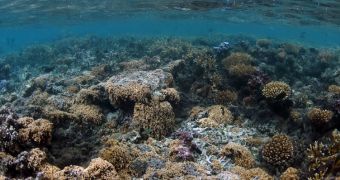Officials at the US National Science Foundation (NSF) announce that they have awarded 21 new research grants to research groups conducting research into oceanic acidification.
The phenomenon is spread on a global scale, and it refers to a drop in the pH levels of saltwater. As this happens, the seas and oceans become more acidic, and less hospitable for species living within.
The process itself is generated by a very simple reaction, that of water (H2O) with carbon dioxide (CO2), the most common greenhouse gas we release into the atmosphere.
As smokestacks pump the chemical into the air, the gas is stored in various spots on the planet, including in special rocks, in forests and vegetation, and in the ocean.
The world's waters are responsible for attracting millions of tons of CO2 each year, but, as the gas enters the water, a simple reaction occurs, which results in the formation of carbonic acid.
This chemical is responsible for the changing pH of the oceans. This shift has far reaching implications for biodiversity, as well as for the ecosystems in which they live.
Under the Ocean Acidification theme of its Climate Research Investment initiative, the NSF is working hard to investigate this worrying trend, and to identify possible ways of mitigating it.
The Office of Polar Programs, the Directorate for Geosciences, and the Directorate for Biological Sciences, all divisions of the Foundation, are involved in supporting the new grants.
“Ocean acidification likely affects marine ecosystems, life histories, food webs and biogeochemical cycling,” explains the director of the NSF Office of Polar Programs, Karl Erb.
“We need to understand the chemistry of ocean acidification and its interplay with marine biochemical and physiological processes – before Earth's seas become inhospitable to life as we know it,” he adds.
The main goal that all the 21 grants share in common is identifying how ocean acidification affects ecosystems and biodiversity now, the nature of its extent and effects in the past, as well as possibilities for the future.
“Earth system history informs our understanding of the effects of ocean acidification on the present-day and future ocean,” explains the assistant director of the NSF Directorate for Geosciences, Tim Killeen.
“For a true comprehension of how acidification will change the oceans, we must integrate paleoecology with marine chemistry, physics, and ecology, and an understanding of the past environmental conditions on Earth,” he concludes.

 14 DAY TRIAL //
14 DAY TRIAL //